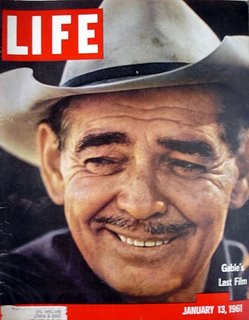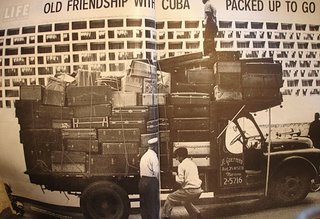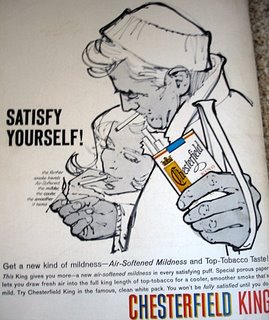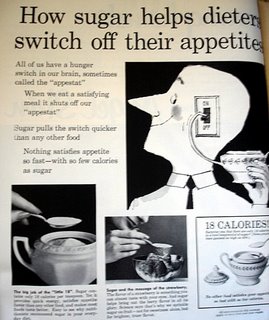A fallen star, rumors of war and wasted women: the way we wuz, Life magazine, Jan. 13, 1961

I have this batch of old magazines I retrieved following the deaths of my parents.
The Jan. 13, 1961, issue of Life has Clark Gable on the cover, and a very brief interview within that took place on the set of The Misfits, which turned out to be Gable's last movie, as he died after filming wrapped. In the index, the magazine promised that Gable "reveals some surprising things about himself," but the short piece contain's nothing "surprising" in today's context of sexual pecadilloes, substance abuse and self-absorbed personality angst, so it's clear the piece was thrown together to capitalize on the movie legend's death. Marilyn Monroe, his co-star in that film, would die Aug. 5, 1962.
Laos was in the news during this week in Life. Pathet Lao guerillas had clashed with government troops. Life ran an editorial questioning the USA's ability to fight limited ground wars, and quoted a fellow named Henry Kissinger to back up its editorial stance. The country had plenty of nuclear weapons, it concluded, but not enough ground troops to fight "brush-fire wars." The USA has to figure out if Laos was worth fighting for, Life opined. Not a word was said about Vietnam. (John F. Kennedy was set to assume office in about a week when this issue came out.)
In an accompanying story by Stanley Karnow, the Time-Life bureau chief in Hong Kong, the headline says: "The Mess in Laos." It turns out the USA had spent $300 million in foreign over 5 years and accomplished little. (Imagine!) They bought cars, jeeps and trucks for the Laotian army, but they were of little use as there were few roads to drive them on. Laotian "businessmen" took the USA to the cleaners, too, and "one American construction company was getting favored treatment from U.S. officials. It was receiving money and equipment but there were doubts not only about how the contracts were arranged, but if they being properly fulfilled." (Imagine!!)
Further back in the magazine is a photo essay on "The Foot Soldier" along with a brief story on the need for more "modern hardware" for "new wars."
"Last year the Army drew up a 'shopping list' of $928 million worth of items it wanted most...One of them, the lightweight M-14 rifle which can fire at the rate of 750 rounds per minute, costs about $115 and is the first rifle the Army has developed in 23 years. Congress looked over the whole list, lit into it and wound up providing $158 million instead of the $928 million."

Life was also hot on the ongoing revolution in Cuba, featuring a two-page photo of a truck loaded with American baggage outside the U.S. embassy. "Old Friendship With Cuba Packed Up To Go," the overline caption states.
Here's the lede of the story: "Diplomats' baggage stacked high on a truck was the sure symbol that Fidel Castro has at last worn out the patience of the United States. Celebrating his second anniversary as the Caribbean island's dictator, he charged that the U.S. embassy staff in Havana was a `swarm of agents' and must forthwith be cut down to only 11 persons."
Agents? Us? HUH?
Life reporter Norman Ritter and photographer Paul Shutzer were jailed for 24 hours in attempting to cover the story, which included widespread rumors of a coming American invasion, so this issue includes a first-person account of their ordeal.
"A hunt-and-peck typicst filled out our record cards with all the speed of a dying burro, while her companion with a mugshot camera struggled to get her Yankee subjects' heads centered in the focusing mirror. Then we went to another room where we were interrogated by a clean-shaven soldier who boasted he was the brother of Che Guevara, Cuba's No. 2 man. He told us six million Cubans were ready to repel the American invasion. When he remarked he had played minor league baseball in the States, I told him I knew Pedro Ramos, the Cuban pitcher for the former Washington Senators. `I know Pedro Ramos, too,' he said curtly.
The CIA's Bay of Pigs Invasion did a belly flop about 3 months later.
Elsewhere in the mag, there was a story about the new president of Radcliffe College, Mary Bunting, entitled "Our Greatest Waste of Talent Is Woman."
"We don't know if woman scientists are as competent as man. We've simply never bothered to find out..." she says on Page 63.
Bunting had formed the Radcliffe Institute for Independent Study, which set up scholarships for gifted women whose careers were interrupted by marriage and resident fellowships for women with distinguished records.
"When her last child is off to school...we don't want the talented woman wasting her time in work far below her capacity. We want her to come out running."
The two main scources of waste, Dr. Bunting said, are "the hidden dissuaders" who "shunt gifted girls away from unladylike courses and the inflexible, male-oriented higher education system which makes no provision for girls who want to continue in their field while raising families."
Curiously, the next story, on Page 66, features a full-page picture of "the newest version of the bikini."
"...(it) has the look of lingerie."
There are four more color photo pages of women in swimsuits and casual wear taken in St. Tropez, which is "a major proving ground for playclothes to become big U.S. hits."
Then, on Page 72, Life carries a story and photo spread by Sir Edmund Hilary and his four-month expedition to the Himalayas to determine if the "abominable snowman" exists.
He doesn't.

;
Of course, the thing that made it go 'round and 'round, economically speaking, is the advertising.
What were they advertising back in '61? Cigarettes and automobiles. Smooth-tasting cigarettes and American-made automobiles. The people who were smoking and driving were all white, and there was nary a foreign-made automobile to be found.
Life also was advertising the World Book Encyclopedia for $179, which they said would "Take your child out of the crowd..." and Sealy Posturepedic mattresses for $39.95 ... and Pazo Formula "stainless" hemmorhoid ointment and suppositories that combine "seven modern medications in one complete formula" (but which, apparently, lost the hemmie wars to the juggernaut that was Preparation H.)
A full-page add also extolled the dietary wonders of SUGAR: "No other food satisfies your appetite so fast with so few calories." (courtesy, Sugar Information, Inc., a non-profit organization.)
Finally (and we're just scratching the surface of the ads), there was a tantalizing offer for a "FREE Panorama Colorslide Projector."
To receive the projector (which, "through a specially designed lens system you can project large, brilliant, full-color images -- just a few feet from where you sit...so simple and safe to use that even a child can operate it.") all that was required was to enroll in a "fascinating" monthly program for $3.98.
Besides the projector, each month subscribers would receiving a "long-playing" record featuring a distinguished commentator (Charles Boyer, Walter Cronkite, Edward R. Murrow, Vincent Price) who would narrate your journey to exotic places.
Did we mention the projector was the product of "years of research"?
Contained within the old Life was the business reply "Via Airmail" postcard, which noted, "If you have neither a screen nor a white wall for showing the slides, you may have a 31" x 24" projection screen, with smooth, matte-white surface for maximum image sharpness. It's a $5.50 value -- yours for only $2.00 (plus mailing charges) if you check this box."
Anyway, that's the way Life wuz on Jan. 13, 1961.
We hope you enjoyed our journey to the past. Perhaps we'll go on another trip soon. Like I said, I've got a big stack of these magazines.















6 comments:
That really took me back. My family subscribed to Life, and I recognized that cover immediately. Often the ads are more interesting to me than the other content of old magazines, so thanks for including some of them.
My father and I used to scour garage sales, used book stores and Salvation Army stores for old magazines, especially Life, Look, Paris Match and National Geographic. The best part of finding realy old ones was by far the advertising.
bill, caca:
maybe in my next installment i'll lede with the ads. i tend to agree with you on that score.
Well, damn it, I haven't had a cigarette in over two years, and I see that Chestbuster ad, and I can taste it.
I taste the paper, and the little bits of tobbacco that sometimes stick to your lips or tongue and you have to pppppftt them off, and I taste that thick, sort of sweet smoke...
Never mind.
sorry, JD. but i held back from quoting the ad copy, so i guess i was somewhat sensitive to reformed smokers.
I love Life, too. Clark Gable was one of those leading men in that golden era of moviemaking where they were more dignified and always looked well-dressed even when acting out less-than-dignified roles. Movies were masterpieces, well, at least the good ones. Now, they're classics.
Post a Comment